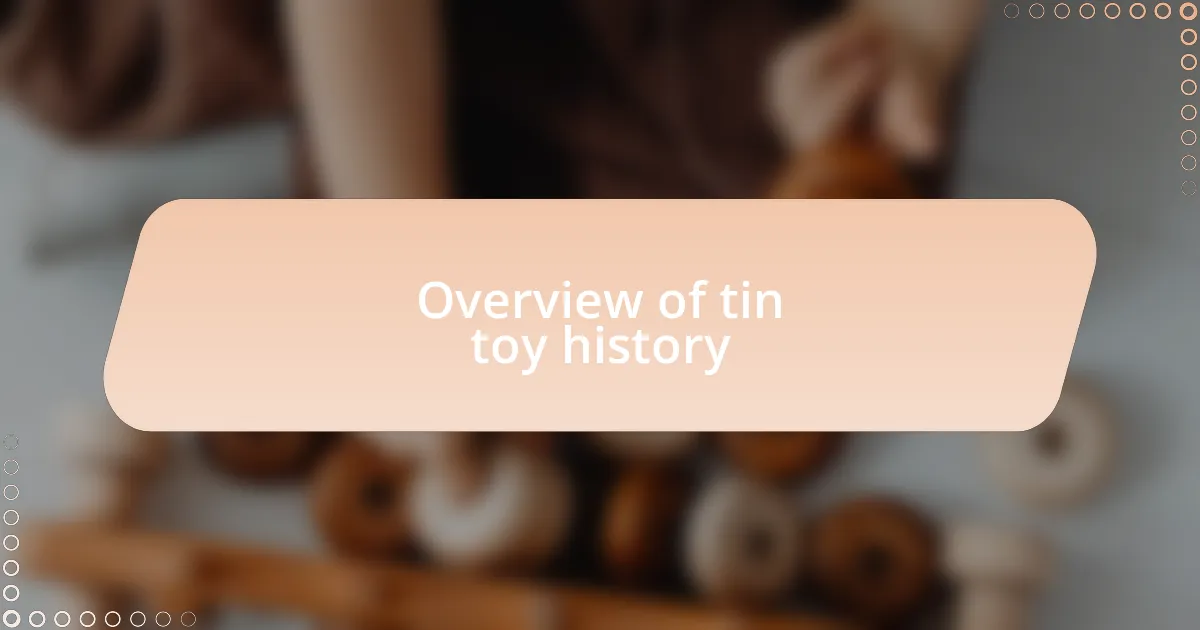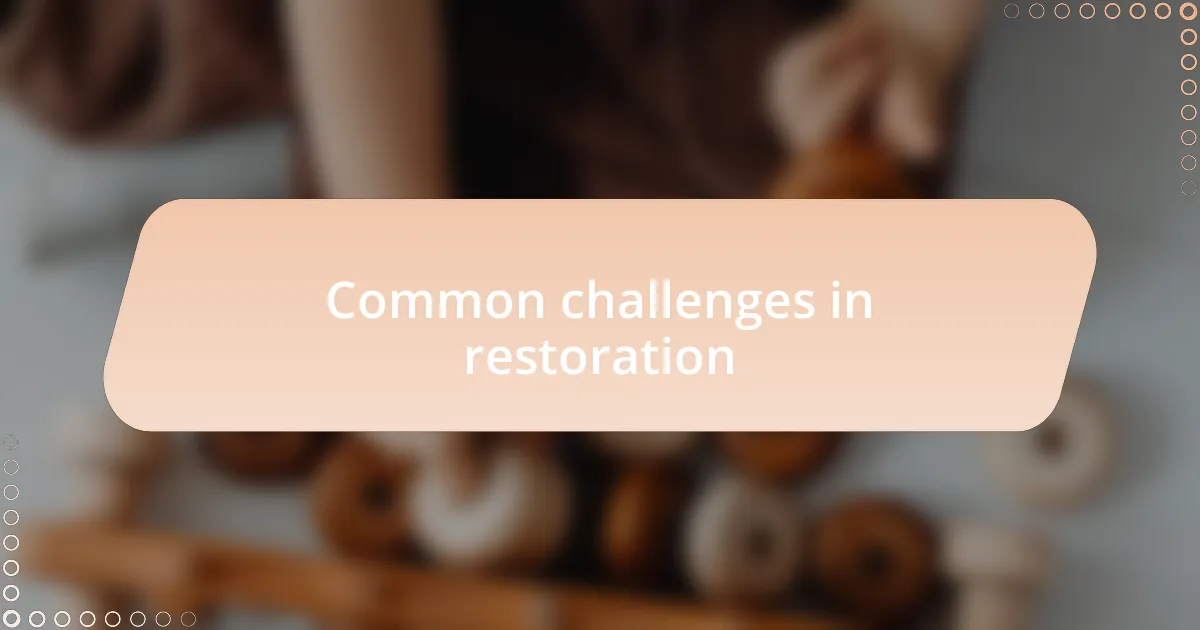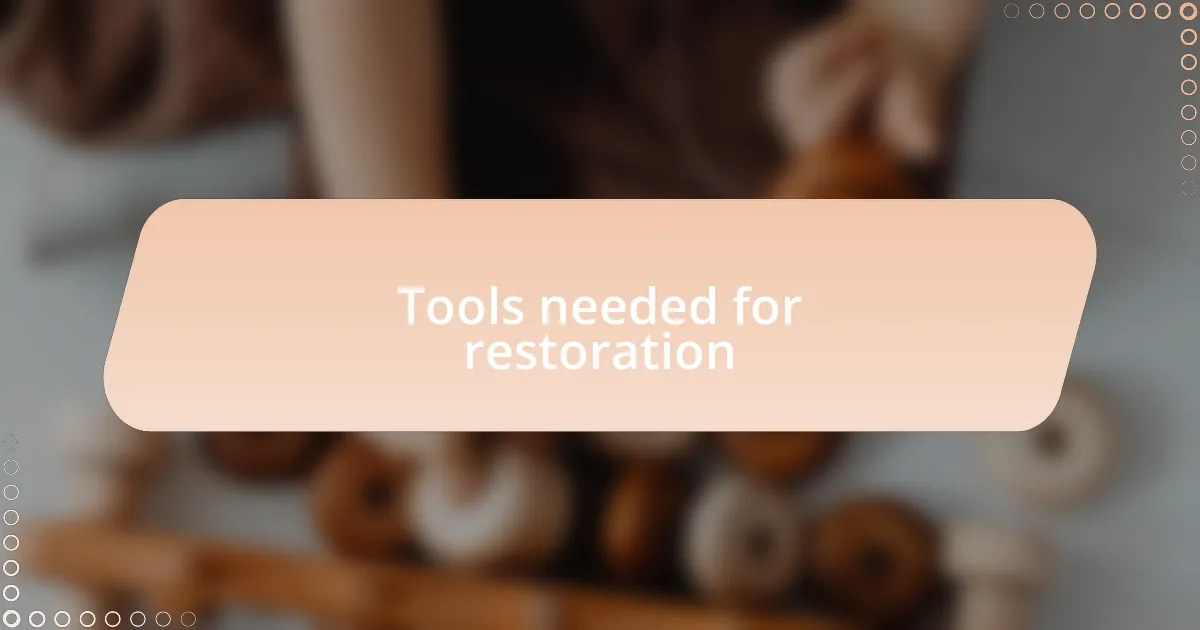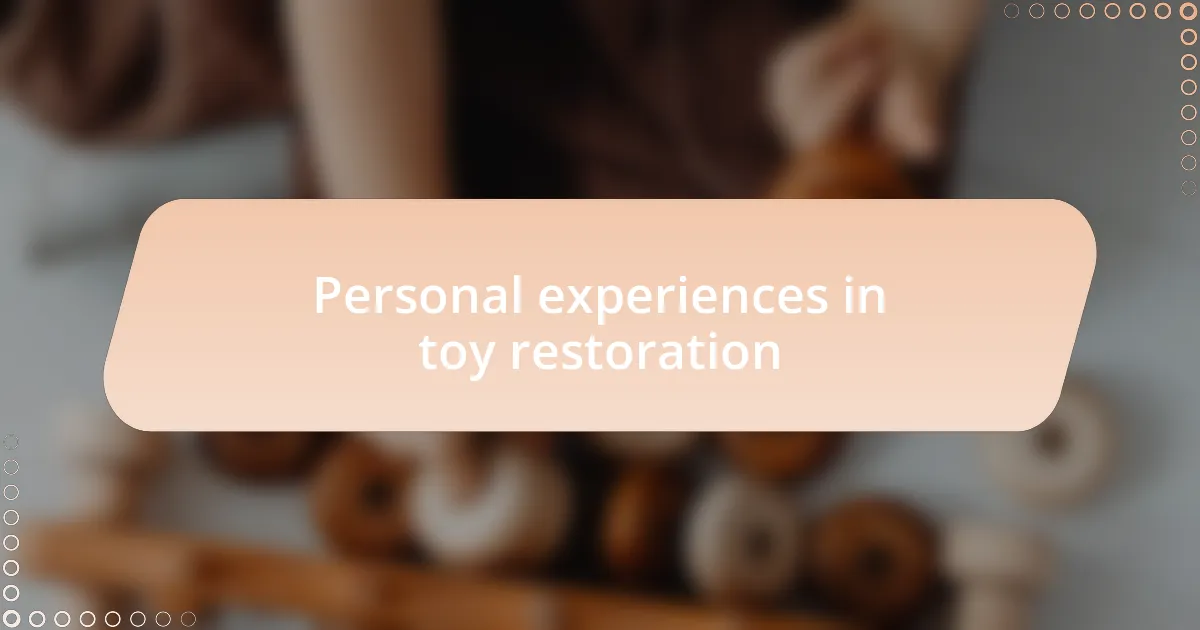Key takeaways:
- Vintage toys evoke nostalgia and connect generations by showcasing craftsmanship and storytelling through their wear and tear.
- Restoring toys not only preserves their beauty and history but also promotes sustainability by encouraging a mindful approach to consumption.
- Common challenges in restoration include dealing with rust, finding replacement parts, and matching faded colors, requiring patience and community support.
- The right tools, such as fine-tipped screwdrivers and needle-nose pliers, are essential for effective restoration and avoiding damage to delicate components.

Understanding vintage toys
Vintage toys possess a charm that often transcends generations. I remember the first time I laid my hands on a well-worn tin toy; the cool metal brought back a flood of memories from my childhood, igniting a sense of nostalgia that is hard to articulate. Isn’t it fascinating how a simple object can connect us to our pasts in such a profound way?
When I restored my first tin toy, I was struck by the craftsmanship that went into creating these pieces. Every dent and scratch told a story, revealing not just a toy’s history but also the hands that toyed with it. Have you ever noticed how older toys often come with intricate details that today’s mass-produced options lack? This artistry is a reminder of the love and care that went into playtime before we gravitated toward technology.
Understanding vintage toys extends beyond their aesthetics; it involves appreciating their role in shaping childhood experiences. I often reflect on how these toys sparked my imagination, turning ordinary moments into extraordinary adventures. How many of us can trace our creativity back to the toys we cherished? It’s not just about nostalgia; it’s about recognizing how these pieces of history have impacted our lives, encouraging exploration and creativity even decades later.

Importance of restoring toys
Restoring toys is essential not just for preserving their beauty, but also for maintaining the stories they carry. When I carefully cleaned up the rusted surfaces of a once-bright tin car, I felt as if I was reviving a little piece of history. What stories did this toy witness? Each scratch and faded color is a reminder of the joy it brought to a child, making the act of restoration feel like a heartfelt tribute.
It’s also important to recognize that restoring toys can foster deeper connections between generations. I remember sharing my restored tin robot with my young niece, who was utterly captivated. As we played together, I could see her imagination ignite, and it struck me how these vintage toys can bridge the gap between old and new, teaching younger ones the value of creativity and the joy of hands-on play. Have you ever seen a child’s eyes light up when they discover something that has passed through many hands before them?
Moreover, restoring vintage toys contributes to sustainability. In a world where throwaway culture dominates, bringing these toys back to life inspires a more thoughtful approach to consumption. I find a certain satisfaction in knowing that instead of discarding an old toy, I chose to invest time and effort into giving it a second chance. Doesn’t it feel rewarding to know that you’re preserving a small piece of the past for future generations, instead of adding to the cycle of waste? Restoring toys is not just a hobby; it’s a responsible act that honors history while promoting a more sustainable future.

Overview of tin toy history
The history of tin toys dates back to the early 19th century, beginning in Germany, where they were first mass-produced. I’ve often marveled at how these toys transformed from simple handcrafted pieces into mechanical wonders, captivating children’s imaginations during the industrial boom. Can you imagine the thrill a child must have felt watching a wind-up tin train zoom across the floor?
As the years went on, tin toys became synonymous with playtime in households around the globe. Companies like Schuco and Bandai emerged, creating intricate designs that not only delighted children but also reflected the artistry of the time. When I restored a colorful tin circus featuring acrobats and animals, I couldn’t help but feel connected to the families who once cherished these toys. It made me ponder, what history lay behind each playful figure?
The decline of tin toy production began in the late 20th century, overshadowed by the rise of plastic and electronic toys. Yet, even as trends changed, I realized that these vintage treasures still hold a special place in many hearts. Every time I see those shiny surfaces and hear the familiar clinks and clatters from a well-loved tin toy, I’m reminded that their legacy is woven into the fabric of childhood joy. Doesn’t it make you reflect on how some toys can truly stand the test of time?

Common challenges in restoration
When restoring tin toys, one of the most common challenges I faced was dealing with rust and corrosion. These toys, often forgotten in attics or basements, can succumb to moisture over time. I remember the disappointment of finding a beloved tin car covered in rust. It took hours of careful cleaning and treating to bring it back to life, a process that taught me the importance of patience and gentleness.
Another hurdle is finding replacement parts. Sometimes, specific wheels or arms are missing or broken, and sourcing exact matches can be a daunting task. I once spent weeks scouring online marketplaces and chatting with fellow collectors, hoping to stumble upon that elusive piece. It’s moments like these that really drive home the sense of community in this hobby, as others understand your frustrations and triumphs.
Lastly, matching colors during the restoration process can be tricky. If the original paint has faded or chipped, I often find myself standing in my workshop, staring at paint swatches, trying to recreate that vibrant hue from memory. Have you ever tried to perfectly match a vintage color? It’s an intricate dance of art and science, and I learned that sometimes, imperfection is what gives a restored toy its unique character and charm.

Tools needed for restoration
When diving into the restoration of tin toys, having the right tools can make a world of difference. I always ensure I have a fine-tipped screwdriver set on hand, as these delicate screws often secure fragile parts. The moment I tried using a flathead screwdriver on an old tin robot and ended up stripping the screws, I learned the hard way just how crucial the proper tool can be in this process.
Besides screwdrivers, a good pair of needle-nose pliers is invaluable for precise adjustments, particularly when dealing with small components. I vividly recall a restoration project where a tiny gear was misaligned; using those pliers, I was able to make the adjustments without any damage. It’s moments like that when I appreciate how the right tool can make seemingly impossible tasks manageable.
Of course, I can’t emphasize enough the importance of a soft cloth for cleaning. It might sound simple, but trust me, using the right material avoids scratches that could detract from a toy’s charm. I recall wiping down a rusty wind-up car with too much pressure and gasping as I noticed a new scratch appear where none existed before. It’s a gentle reminder that restoration is about enhancing beauty, not creating more challenges.

Personal experiences in toy restoration
Restoring tin toys has been a journey of rediscovery for me. I remember unearthing an old wind-up robot from my childhood attic, covered in dust and rust. As I carefully peeled away the layers of neglect, I felt a rush of nostalgia; each dent and scratch told a story waiting to be revived. Isn’t it fascinating how an object can hold so much history?
One of my most memorable projects involved a tin airplane that had seen better days. I was daunted by the task at first, especially when I wrestled with reassembling its wings. After wrestling with that puzzle for hours, I finally managed to snap everything back into place, and that triumphant moment made every frustration worth it. How often do we forget the personal satisfaction that comes from restoring something back to life?
In another instance, I learned that patience truly is a virtue. While repairing a delicate toy that had intricate artwork, I took my time, meticulously working on each painting flaw. At times, I grew frustrated, but stepping back to appreciate the gradual transformation reminded me why I love this craft. Isn’t it amazing how restoration mirrors our own journeys of healing and growth?